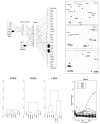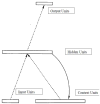Letting structure emerge: connectionist and dynamical systems approaches to cognition
- PMID: 20598626
- PMCID: PMC3056446
- DOI: 10.1016/j.tics.2010.06.002
Letting structure emerge: connectionist and dynamical systems approaches to cognition
Abstract
Connectionist and dynamical systems approaches explain human thought, language and behavior in terms of the emergent consequences of a large number of simple noncognitive processes. We view the entities that serve as the basis for structured probabilistic approaches as abstractions that are occasionally useful but often misleading: they have no real basis in the actual processes that give rise to linguistic and cognitive abilities or to the development of these abilities. Although structured probabilistic approaches can be useful in determining what would be optimal under certain assumptions, we propose that connectionist, dynamical systems, and related approaches, which focus on explaining the mechanisms that give rise to cognition, will be essential in achieving a full understanding of cognition and development.
Copyright 2010 Elsevier Ltd. All rights reserved.
Figures



Comment in
-
Theory-driven modeling or model-driven theorizing? Comment on McClelland et al. and Griffiths et al.Trends Cogn Sci. 2010 Aug;14(8):343-4. doi: 10.1016/j.tics.2010.05.009. Epub 2010 Jun 17. Trends Cogn Sci. 2010. PMID: 20561812 No abstract available.
-
Emergent and structured cognition in Bayesian models: comment on Griffiths et al. and McClelland et al.Trends Cogn Sci. 2010 Aug;14(8):345-6. doi: 10.1016/j.tics.2010.05.011. Epub 2010 Jun 17. Trends Cogn Sci. 2010. PMID: 20561813 No abstract available.
-
Cognitive Science should be unified: comment on Griffiths et al. and McClelland et al.Trends Cogn Sci. 2010 Aug;14(8):341. doi: 10.1016/j.tics.2010.05.008. Epub 2010 Jun 17. Trends Cogn Sci. 2010. PMID: 20561814 No abstract available.
-
Why emergentist accounts of cognition are more theoretically constraining than structured probability accounts: comment on Griffiths et al. and McClelland et al.Trends Cogn Sci. 2010 Aug;14(8):340. doi: 10.1016/j.tics.2010.05.013. Epub 2010 Jun 26. Trends Cogn Sci. 2010. PMID: 20580306 No abstract available.
-
A computational foundation for cognitive development: comment on Griffths et al. and McLelland et al.Trends Cogn Sci. 2010 Aug;14(8):342-3. doi: 10.1016/j.tics.2010.05.012. Epub 2010 Jun 28. Trends Cogn Sci. 2010. PMID: 20591723 No abstract available.
-
Bridging levels of analysis: comment on McClelland et al. and Griffiths et al.Trends Cogn Sci. 2010 Aug;14(8):344-5. doi: 10.1016/j.tics.2010.05.007. Epub 2010 Jun 16. Trends Cogn Sci. 2010. PMID: 20678716 No abstract available.
-
Neither size fits all: comment on McClelland et al. and Griffiths et al.Trends Cogn Sci. 2010 Aug;14(8):346-7. doi: 10.1016/j.tics.2010.05.010. Epub 2010 Jun 17. Trends Cogn Sci. 2010. PMID: 20678717 Free PMC article. No abstract available.
References
-
- Johnson SB. Emergence: The connected lives of ants, brains, cities, and software. New York: Scribner’s; 2001.
-
- Griffiths TL, Chater N, Kemp C, Perfors A, Tenenbaum J. Probabilistic models of cognition: Exploring the laws of thought. Trends in Cognitive Sciences. 2010;XX:xxx–xxx. - PubMed
-
- Marr D. Vision. W. H. Freeman; San Francisco, CA: 1982.
-
- Chomsky N. Aspects of the theory of syntax. Cambridge, MA: MIT Press; 1965.
-
- Sternberg D, McClelland JL. When should we expect indirect effects in human contingency learning? In: Taatgen NA, van Rijn H, editors. Proceedings of the 31st Annual Conference of the Cognitive Science Society. Austin, TX: Cognitive Science Society; 2009. pp. 206–211.
MeSH terms
Grants and funding
LinkOut - more resources
Full Text Sources

